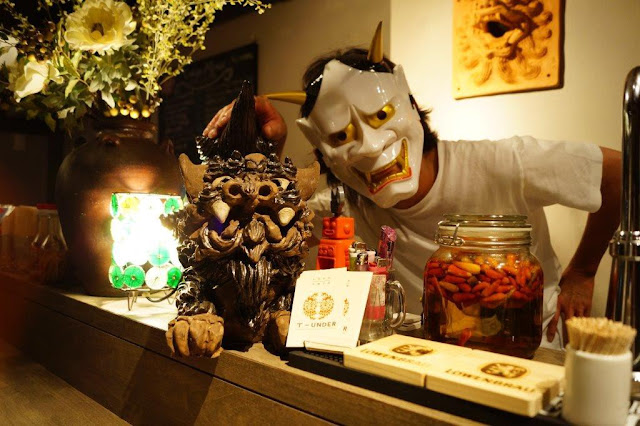HANNYA: THE MASK OF ENVY AND ANGER
These two masks are called the Hannya masks (Hannya no men 般若の面) and they represent the transformation of a woman into a demon because of her jealousy and resentment towards the lover who betrayed her (shitto ya urami no komoru Onna 嫉妬や恨みの篭る女の顔)
They are used in the traditional Japanese theatre (noh theatre 能) and have become a symbol of Japanese pop culture, easily seen in anime, video games and tattoos.
 Name: The name hannya (般若, Sanskrit: प्रज्ञा, prajñā) is a Buddhist term meaning "wisdom". According to the tradition, this name was given to this mask because it was the name of the monk Hannya-bō (般若坊) who is said to have perfected its creation: the artist monk needed a great wisdom in order to create this mask. Another tradition says that the mask was called Hannya after that in the Tale of Genji, Japanese most famous long novel, reading the Hannya's sutra defeated jealous and angry demons.
Name: The name hannya (般若, Sanskrit: प्रज्ञा, prajñā) is a Buddhist term meaning "wisdom". According to the tradition, this name was given to this mask because it was the name of the monk Hannya-bō (般若坊) who is said to have perfected its creation: the artist monk needed a great wisdom in order to create this mask. Another tradition says that the mask was called Hannya after that in the Tale of Genji, Japanese most famous long novel, reading the Hannya's sutra defeated jealous and angry demons.
In modern Japan Hannya is no longer common as a Buddhist word but it is used to mean the mask or a face full of anger.
Description: The mask is of a woman/demon, it still possesses the shape of a human face and human hair, but it's changing into a demon and so it has two sharp bull-like horns, metallic eyes (gold or silver), and a leering mouth with golden teeth. Gold and silver are the colours of the supernatural. It is very hard to make the Hannya mask because of its expression: it is frightening and dangerous but also sorrowful and tormented, displaying the complexity of human emotions. When the actor looks straight ahead, the mask appears scaring and angry; when the actor tilted slightly down, the face appears extremely sad.
Types: Since the Hannya mask represent the transformation of a woman into a demon, there are different masks for each mutation, with different shape, colours and costumes.
FIRST LEVEL: Unfinished Namanari 生成 〜 Deigan 泥眼
The white mask indicates a woman with a refined character and from a noble and respectable family as shown by the make up with fair skin, shaved eyebrows and the fake eyebrows painted in the upper part of the front and the hairstyle (such as the aristocratic lady Rokujō in Aoi no Ue). However, the horns and the golden/silver eyes and teeth are a proof that she has been possessed : her transformation into a demon has started after the discovery of the betrayal of the lover.
SECON LEVEL: Middle stage Chuunari 中成 〜 Hannya 般若
A red mask depicts a less refined character, from a frontal point of view the mask shows its anger and from down it shows its sorrow (like the spirit of peasant girl seen in Dōjōji). It's a middle stage and the most common and popular mask of the transformation.
THIRD LEVEL: True form Honnari 本成 〜 Shinja 真蛇
A dark red, sometimes black, depicts the true demon (revealed after appearing as women, as in Momijigari and Kurozuka). The sorrow has gone from her face and now there is only anger, rage and the desire of revenge. The expression of the mask is extreme and its demonic nature is clear except for the hairstyle that still reminds of her old human origin. The transformation into a demon is completed and it appears to be a snake, the real snake: shinja 真蛇.
Traditional use: The oldest hannya mask is dated 1558, but they have been created since Kamakura period (1185-1333) when most of Japanese theatric genre were born. In, fact, it is probably during Kamakura period that the mask's characteristics were completed during this period: the Hannya mask were popular and "sacred" because of its strong feelings of revenge that helped the main actor (shite) to call the spirits, the gods and all the hidden passions within the human beings. As in many other cultures, in Japan, it is still believed that wearing masks enables people to transform themselves, giving supernatural physical and mental superpowers and the chance to become a god.
Popular culture: Hannya has become a symbol of Japan and extremely popular as a tattoo or a character in anime and video games. In fact, despite it is an angry demon, its colour red is also considered a good omen, expression if youth and able to protect from dangers and the evil: the color red in Japan is associated with the sun and life.







Comments
Post a Comment